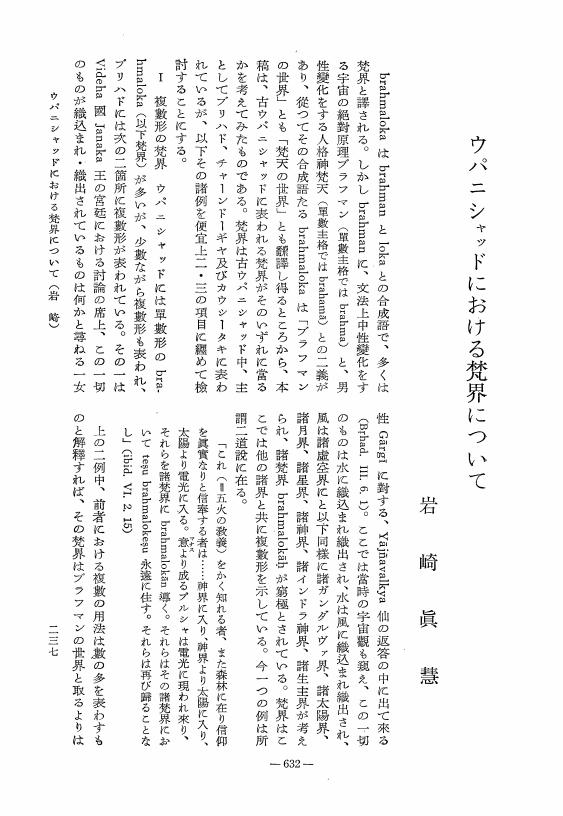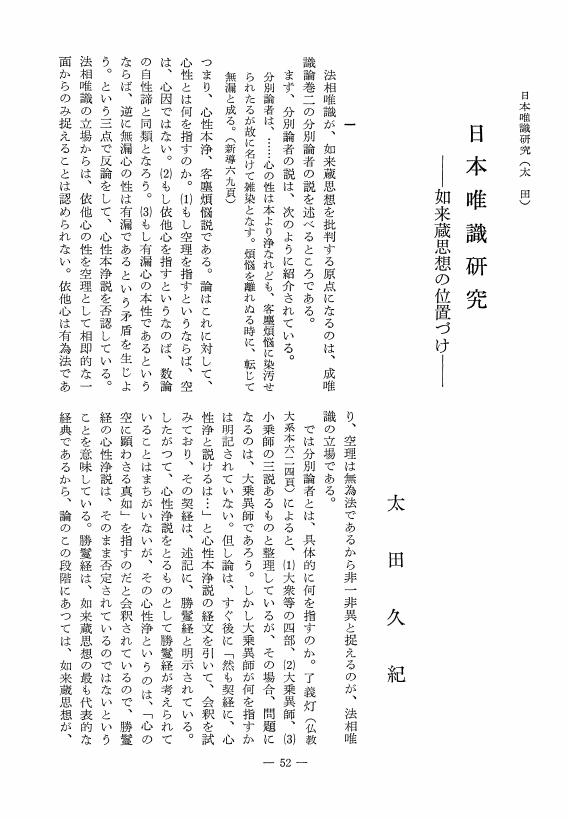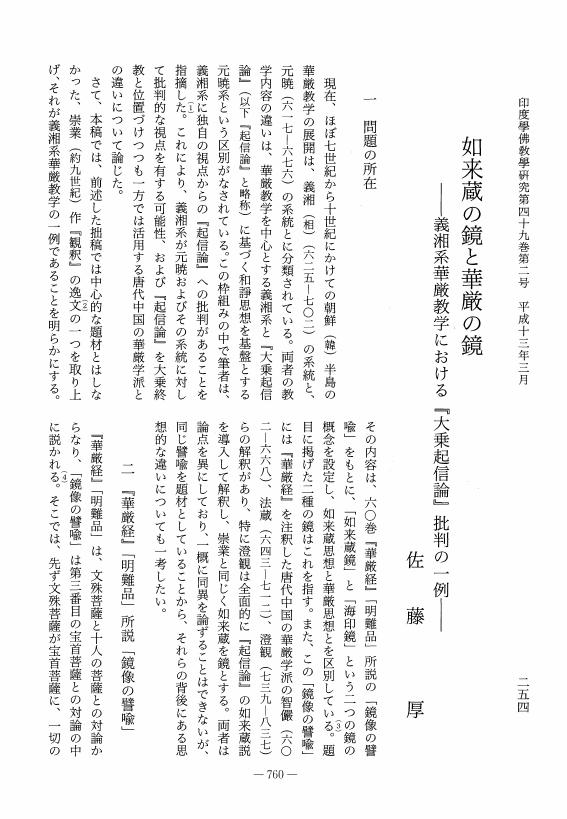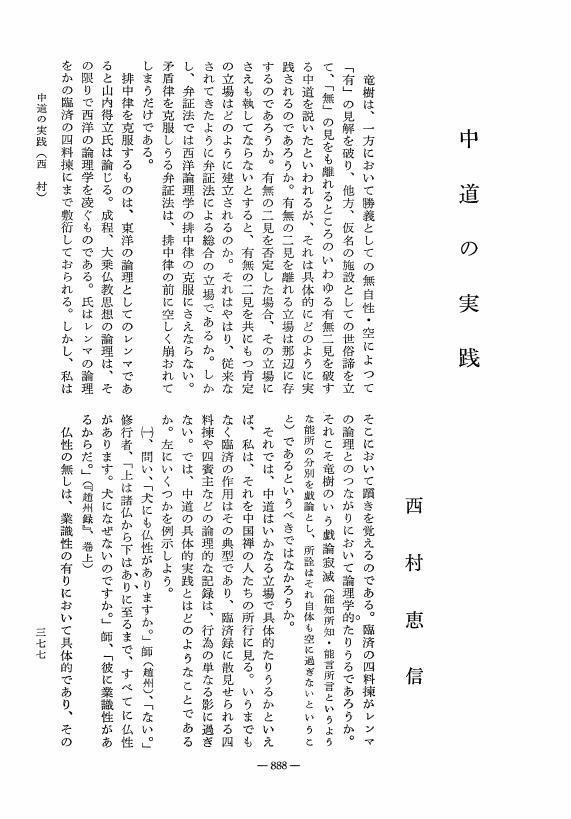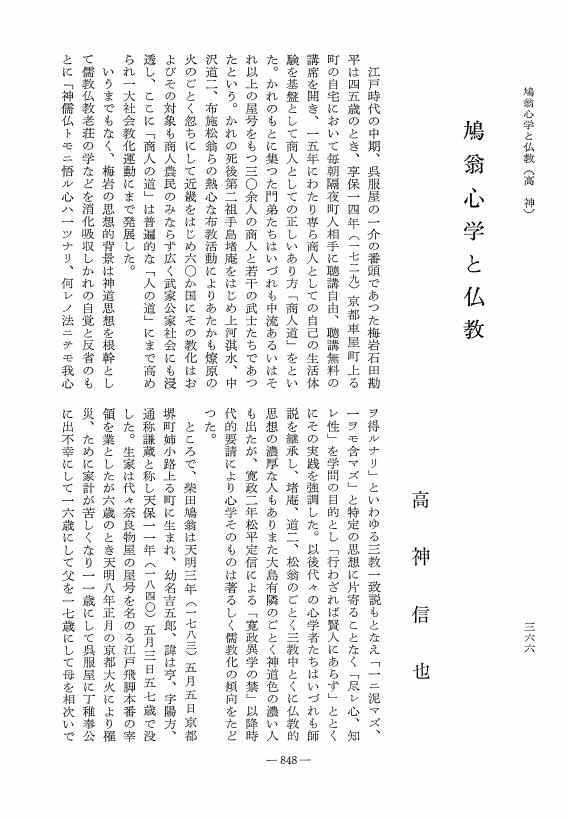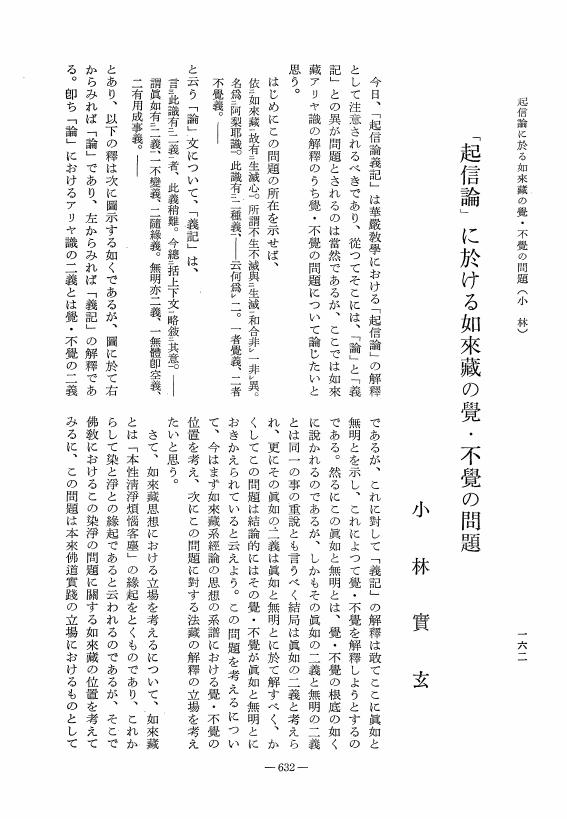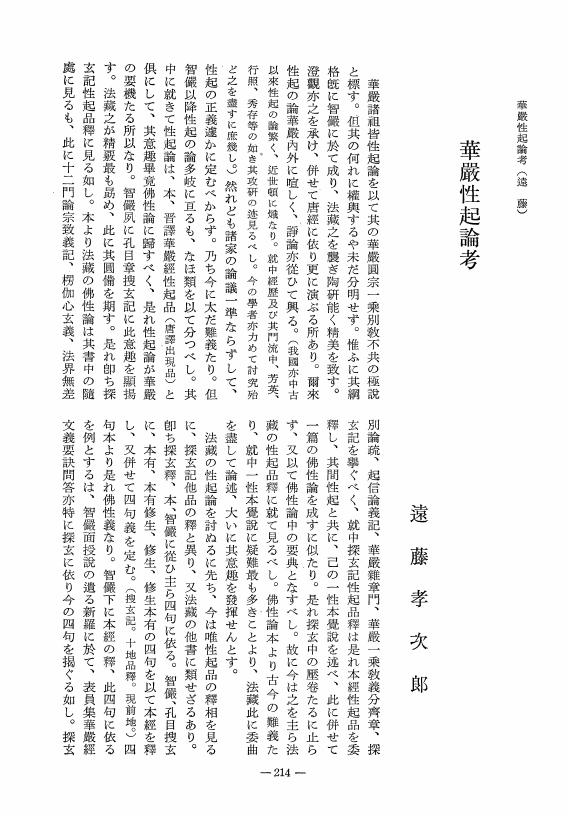1 0 0 0 OA 律的側面からみた『文殊般若経』-大乗経典の経・律相即性-
- 著者
- 立花 弥生
- 出版者
- Japanese Association of Indian and Buddhist Studies
- 雑誌
- 印度學佛教學研究 (ISSN:00194344)
- 巻号頁・発行日
- vol.48, no.2, pp.1061-1059, 2000-03-20 (Released:2010-03-09)
1 0 0 0 OA 堅樹院日寛における造仏論批判
- 著者
- 水谷 進良
- 出版者
- 日本印度学仏教学会
- 雑誌
- 印度學佛教學研究 (ISSN:00194344)
- 巻号頁・発行日
- vol.69, no.2, pp.527-531, 2021-03-25 (Released:2021-09-06)
- 参考文献数
- 4
Kenjuin Nichikan 堅樹院日寛 (1665–1726) was the 26th chief priest of the Taisekiji 大石寺, the head temple of Nichiren Shōshū. He is famous in the history of Nichiren doctrine as the scholar who systematized the philosophy of the Taisekiji.One assertion of Nichikan’s religious thought is that one should not create statues of the Buddha in the age of the degeneration of the law (mappō 末法). However, Kōzōin Nisshin 広蔵院日辰, who was active about 160 years before Nichikan, had insisted that statues of the Buddha should indeed be erected. In this way, although the two monks belonged to the same “Nikkōmon school (日興門流)”, their ideas differed.Since the religious thought of Nisshin was the mainstream at the Taisekiji at that time, Nichikan severely criticized Nisshin’s claim in his work called the Zōbutsu rongi 造仏論義 in order to change the mainstream religious thought of the Taisekiji to follow his own views.
1 0 0 0 OA 般若経における忍辱波羅蜜
- 著者
- 鈴木 健太
- 出版者
- 日本印度学仏教学会
- 雑誌
- 印度學佛教學研究 (ISSN:00194344)
- 巻号頁・発行日
- vol.68, no.1, pp.401-395, 2019-12-20 (Released:2020-09-10)
- 参考文献数
- 6
This paper investigates the kṣāntipāramitā in the smaller Mahāprajñāpāramitāsūtras. Translated terms in the Daoxing banruo jing 道行般若経 (T. 224), the oldest version of the smaller Mahāprajñāpāramitāsūtras, were examined first. The translator of the Daoxing banruo jing, Lokakṣema, had translated kṣānti into 忍辱, kṣāntipāramitā into 羼提波羅蜜, and anutpattikeṣu dharmeṣu kṣāntiḥ into 無所従生法楽. Moreover, the Daoxing banruo jing barely explained the contents of the practice of kṣānti. In conclusion, the smaller Mahāprajñāpāramitāsūtras did not change the contents of kṣānti practice already known through other sūtras and elsewhere.
1 0 0 0 OA ウパニシャッドにおける梵界について
- 著者
- 岩崎 眞慧
- 出版者
- Japanese Association of Indian and Buddhist Studies
- 雑誌
- 印度學佛教學研究 (ISSN:00194344)
- 巻号頁・発行日
- vol.7, no.2, pp.632-635, 1959-03-30 (Released:2010-03-09)
1 0 0 0 OA Empirical Intuition in Jaina Logic (III)
- 著者
- 長崎 法潤
- 出版者
- Japanese Association of Indian and Buddhist Studies
- 雑誌
- 印度學佛教學研究 (ISSN:00194344)
- 巻号頁・発行日
- vol.27, no.2, pp.941-936, 1979-03-31 (Released:2010-03-09)
1 0 0 0 OA 華厳家の止観に対する解釈
- 著者
- 陳 永裕(本覺)
- 出版者
- Japanese Association of Indian and Buddhist Studies
- 雑誌
- 印度學佛教學研究 (ISSN:00194344)
- 巻号頁・発行日
- vol.53, no.1, pp.309-303, 2004-12-20 (Released:2010-03-09)
1 0 0 0 OA 日本唯識研究 -如来蔵思想の位置づけ-
- 著者
- 太田 久紀
- 出版者
- Japanese Association of Indian and Buddhist Studies
- 雑誌
- 印度學佛教學研究 (ISSN:00194344)
- 巻号頁・発行日
- vol.29, no.1, pp.52-57, 1980-12-31 (Released:2010-03-09)
1 0 0 0 OA 如来蔵の鏡と華厳の鏡 -義湘系華厳教学における『大乗起信論』批判の一例-
- 著者
- 佐藤 厚
- 出版者
- Japanese Association of Indian and Buddhist Studies
- 雑誌
- 印度學佛教學研究 (ISSN:00194344)
- 巻号頁・発行日
- vol.49, no.2, pp.760-764, 2001-03-20 (Released:2010-03-09)
1 0 0 0 OA 法藏における一心の性格について
- 著者
- 鍵主 良敬
- 出版者
- Japanese Association of Indian and Buddhist Studies
- 雑誌
- 印度學佛教學研究 (ISSN:00194344)
- 巻号頁・発行日
- vol.13, no.2, pp.664-667, 1965-03-31 (Released:2010-03-09)
1 0 0 0 OA 法蔵の唯識説への対応
- 著者
- 石橋 真誡
- 出版者
- Japanese Association of Indian and Buddhist Studies
- 雑誌
- 印度學佛教學研究 (ISSN:00194344)
- 巻号頁・発行日
- vol.32, no.2, pp.954-957, 1984-03-25 (Released:2010-03-09)
1 0 0 0 OA 無我の実践について
- 著者
- 朴 京俊
- 出版者
- Japanese Association of Indian and Buddhist Studies
- 雑誌
- 印度學佛教學研究 (ISSN:00194344)
- 巻号頁・発行日
- vol.53, no.1, pp.394-390, 2004-12-20 (Released:2010-03-09)
1 0 0 0 OA 中道の実践
- 著者
- 西村 恵信
- 出版者
- Japanese Association of Indian and Buddhist Studies
- 雑誌
- 印度學佛教學研究 (ISSN:00194344)
- 巻号頁・発行日
- vol.26, no.2, pp.888-891, 1978-03-20 (Released:2010-03-09)
1 0 0 0 OA 鳩翁心学と仏教
- 著者
- 高神 信也
- 出版者
- Japanese Association of Indian and Buddhist Studies
- 雑誌
- 印度學佛教學研究 (ISSN:00194344)
- 巻号頁・発行日
- vol.29, no.2, pp.848-851, 1981-03-31 (Released:2010-03-09)
1 0 0 0 OA 曹洞宗学に立脚する天童如浄研究の問題点
- 著者
- 愛宕 邦康
- 出版者
- 日本印度学仏教学会
- 雑誌
- 印度學佛教學研究 (ISSN:00194344)
- 巻号頁・発行日
- vol.70, no.1, pp.87-94, 2021-12-20 (Released:2022-09-09)
- 参考文献数
- 2
- 被引用文献数
- 1
For the past few years, the author has been conducting research in China at Xuedou si 雪竇寺, where Tiantong Rujing 天童如浄 (1163-1228) trained as a monk, and Tiantong si 天童寺, where he became the abbot. The aim has been to determine the historical facts surrounding Tiantong Rujing and to reestablish his historical image by taking a purely Chinese perspective and by eliminating the persistent biased views strongly centered on Dōgen set forth by doctrinal studies within the Sōtō School 曹洞宗. Philological researches in Japan on Tiantong Rujing have hitherto taken the statements in Dōgenʼs Hōkyōki 宝慶記 and the Shōbōgenzō 正法眼蔵 for granted, and have only used information included in Chinese sources such as the Rujing yulu 如浄語録 in so far as they did not contradict the Japanese sources. This has resulted in enormous incongruity today between the Japanese and Chinese perceptions of Tiantong Rujing. This paper illustrates this through several examples.
1 0 0 0 OA 「起信論」に於ける如來藏の覺・不覺の問題
- 著者
- 小林 實玄
- 出版者
- Japanese Association of Indian and Buddhist Studies
- 雑誌
- 印度學佛教學研究 (ISSN:00194344)
- 巻号頁・発行日
- vol.12, no.2, pp.632-636, 1964-03-31 (Released:2010-03-09)
1 0 0 0 OA 華嚴宗觀行の展開について-縁起觀と性起觀-
- 著者
- 小林 實玄
- 出版者
- Japanese Association of Indian and Buddhist Studies
- 雑誌
- 印度學佛教學研究 (ISSN:00194344)
- 巻号頁・発行日
- vol.15, no.2, pp.653-655, 1967-03-31 (Released:2010-03-09)
1 0 0 0 OA 『起信論』解釋の變遷-華嚴教學展開の根底として-
- 著者
- 小林 實玄
- 出版者
- Japanese Association of Indian and Buddhist Studies
- 雑誌
- 印度學佛教學研究 (ISSN:00194344)
- 巻号頁・発行日
- vol.13, no.2, pp.668-671, 1965-03-31 (Released:2010-03-09)
1 0 0 0 OA 華嚴性起論考
- 著者
- 遠藤 孝次郎
- 出版者
- Japanese Association of Indian and Buddhist Studies
- 雑誌
- 印度學佛教學研究 (ISSN:00194344)
- 巻号頁・発行日
- vol.14, no.1, pp.214-216, 1965-12-25 (Released:2010-03-09)
1 0 0 0 OA 華嚴性起論考(續)
- 著者
- 遠藤 孝次郎
- 出版者
- Japanese Association of Indian and Buddhist Studies
- 雑誌
- 印度學佛教學研究 (ISSN:00194344)
- 巻号頁・発行日
- vol.15, no.2, pp.523-528, 1967-03-31 (Released:2010-03-09)
1 0 0 0 OA 性起思想の成立
- 著者
- 鎌田 茂雄
- 出版者
- Japanese Association of Indian and Buddhist Studies
- 雑誌
- 印度學佛教學研究 (ISSN:00194344)
- 巻号頁・発行日
- vol.5, no.2, pp.523-526, 1957-03-30 (Released:2010-03-09)

